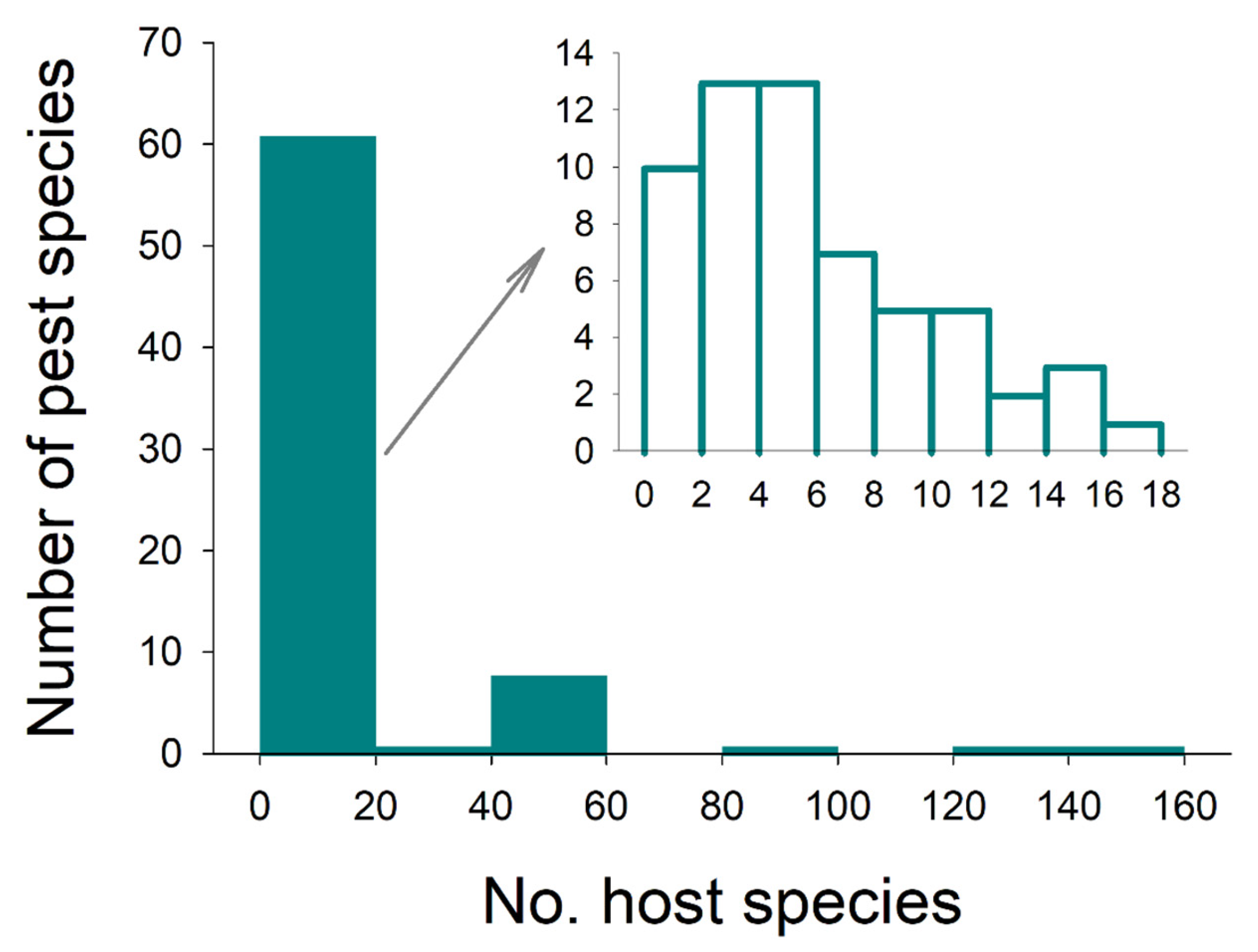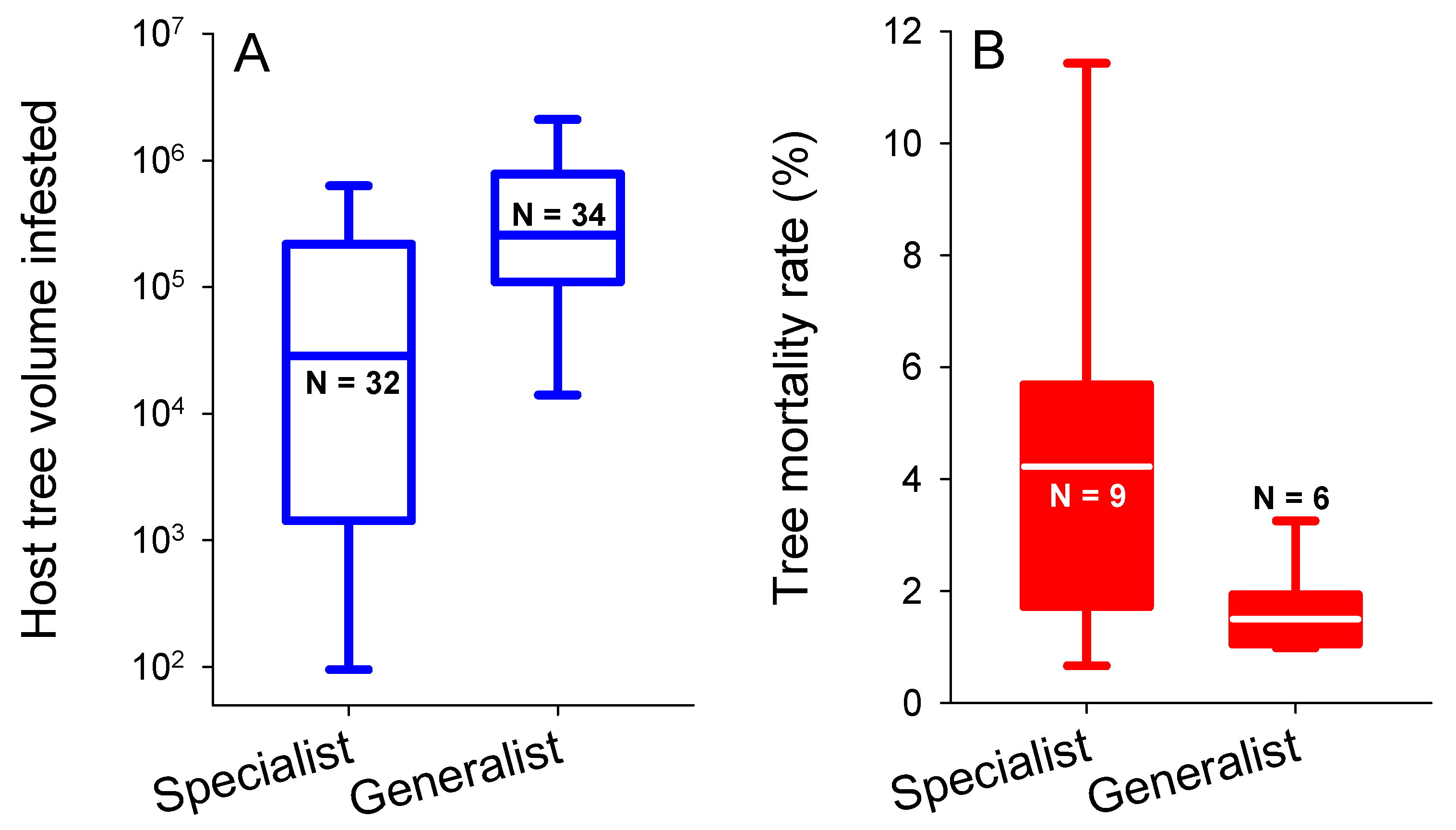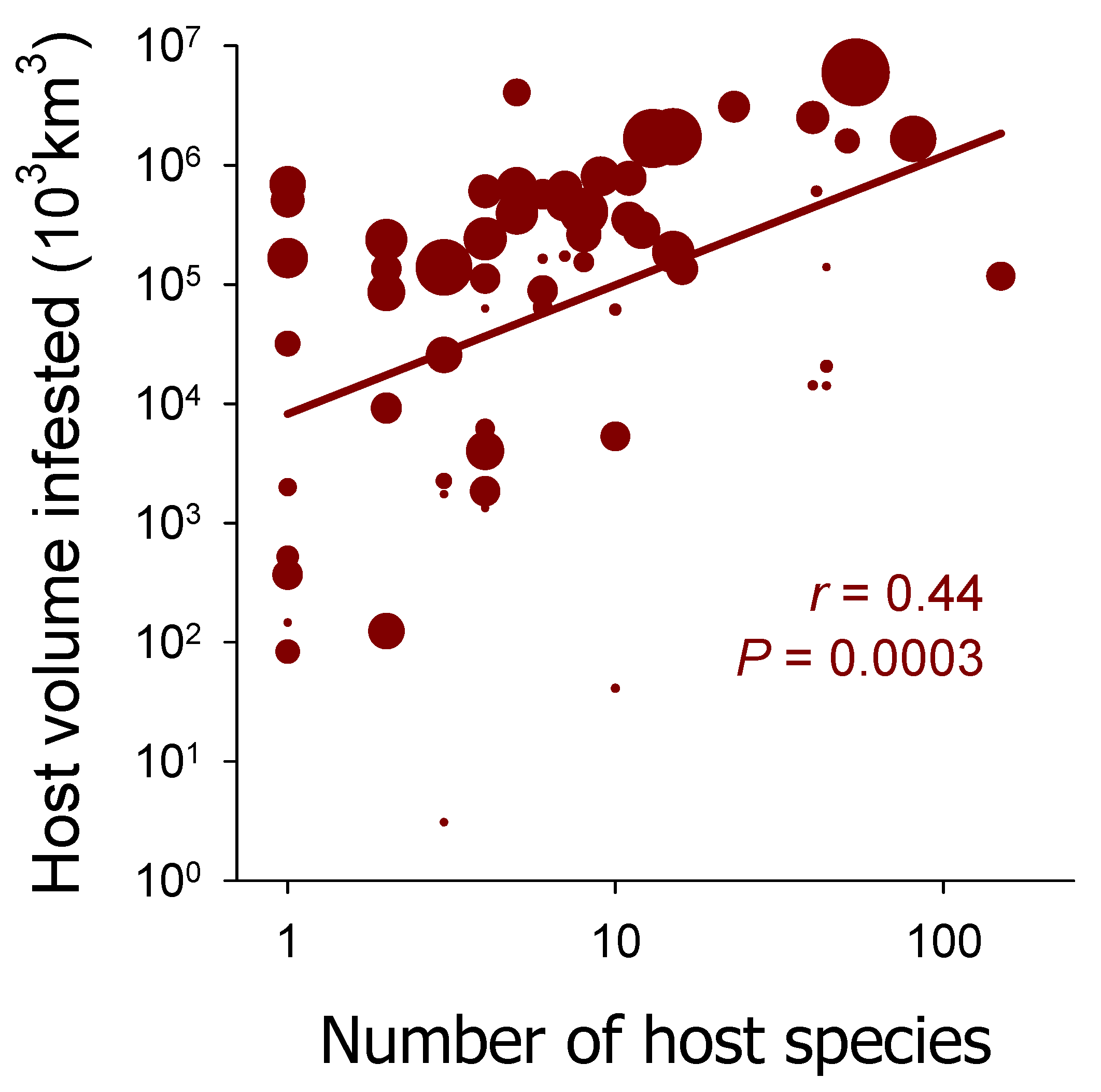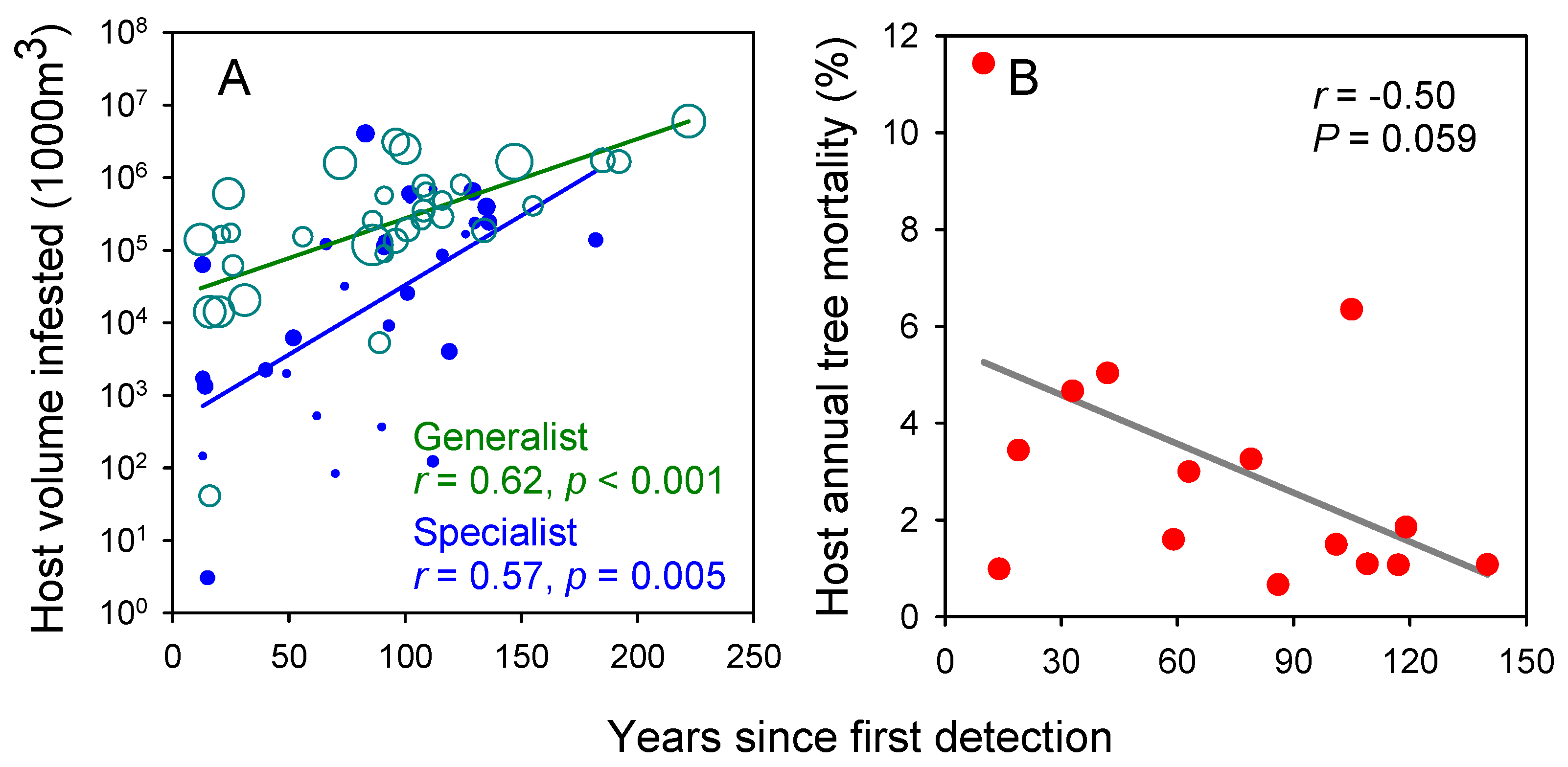Generalist Pests Cause High Tree Infestation, but Specialist Pests Cause High Mortality
Abstract
1. Introduction
2. Materials and Methods
3. Results
4. Discussion
5. Conclusions
Supplementary Materials
Author Contributions
Funding
Data Availability Statement
Acknowledgments
Conflicts of Interest
References
- Liebhold, A.M.; Brockerhoff, E.G.; Kalisz, S.; Nuñez, M.A.; Wardle, D.A.; Wingfield, M.J. Biological invasions in forest ecosystems. Biol. Invasions 2017, 19, 3437–3458. [Google Scholar] [CrossRef]
- Fei, S.; Morin, R.S.; Oswalt, C.M.; Liebhold, A.M. Biomass losses resulting from insect and disease invasions in US forests. Proc. Natl. Acad. Sci. USA 2019, 116, 17371–17376. [Google Scholar] [CrossRef] [PubMed]
- Aukema, J.E.; McCullough, D.G.; Von Holle, B.; Liebhold, A.M.; Britton, K.; Frankel, S.J. Historical accumulation of nonindigenous forest pests in the continental United States. Bioscience 2010, 60, 886–897. [Google Scholar] [CrossRef]
- Brockerhoff, E.; Liebhold, A. Ecology of forest insect invasions. Biol. Invasions 2017, 19, 3141–3159. [Google Scholar] [CrossRef]
- Ward, S.F.; Liebhold, A.M.; Fei, S. Variable effects of forest diversity on invasions by non-native insects and pathogens. Biodivers. Conserv. 2022, 31, 2575–2586. [Google Scholar] [CrossRef]
- Ali, J.G.; Agrawal, A.A. Specialist versus generalist insect herbivores and plant defense. Trends Plant Sci. 2012, 17, 293–302. [Google Scholar] [CrossRef]
- Anderson-Teixeira, K.J.; Herrmann, V.; Cass, W.B.; Williams, A.B.; Paull, S.J.; Gonzalez-Akre, E.B.; Helcoski, R.; Tepley, A.J.; Bourg, N.A.; Cosma, C.T. Long-Term Impacts of Invasive Insects and Pathogens on Composition, Biomass, and Diversity of Forests in Virginia’s Blue Ridge Mountains. Ecosystems 2021, 24, 89–105. [Google Scholar] [CrossRef]
- Bidart-Bouzat, M.G.; Kliebenstein, D. An ecological genomic approach challenging the paradigm of differential plant responses to specialist versus generalist insect herbivores. Oecologia 2011, 167, 677. [Google Scholar] [CrossRef]
- Malavasi, A.; Morgante, J.S.; Prokopy, R.J. Distribution and activities of Anastrepha fraterculus (Diptera: Tephritidae) flies on host and nonhost trees. Ann. Entomol. Soc. Am. 1983, 76, 286–292. [Google Scholar] [CrossRef]
- Dulaurent, A.M.; Porté, A.J.; Van Halder, I.; Vétillard, F.; Menassieu, P.; Jactel, H. Hide and seek in forests: Colonization by the pine processionary moth is impeded by the presence of nonhost trees. Agric. For. Entomol. 2012, 14, 19–27. [Google Scholar] [CrossRef]
- Guo, Q.; Fei, S.; Potter, K.M.; Liebhold, A.M.; Wen, J. Tree diversity regulates forest pest invasion. Proc. Natl. Acad. Sci. USA 2019, 116, 7382–7386. [Google Scholar] [CrossRef] [PubMed]
- Strona, G.; Lafferty, K.D. Environmental change makes robust ecological networks fragile. Nat. Commun. 2016, 7, 12462. [Google Scholar] [CrossRef]
- Liebhold, A.M.; McCullough, D.G.; Blackburn, L.M.; Frankel, S.J.; Von Holle, B.; Aukema, J.E. A highly aggregated geographical distribution of forest pest invasions in the USA. Divers. Distrib. 2013, 19, 1208–1216. [Google Scholar] [CrossRef]
- Jonsen, I.D.; Fahrig, L. Response of generalist and specialist insect herbivores to landscape spatial structure. Landsc. Ecol. 1997, 12, 185–197. [Google Scholar] [CrossRef]
- Hudgins, E.J.; Liebhold, A.M.; Leung, B. Predicting the spread of all invasive forest pests in the United States. Ecol. Lett. 2017, 20, 426–435. [Google Scholar] [CrossRef]
- Liebhold, A.M.; Yamanaka, T.; Roques, A.; Augustin, S.; Chown, S.L.; Brockerhoff, E.G.; Pyšek, P. Plant diversity drives global patterns of insect invasions. Sci. Rep. 2018, 8, 12095. [Google Scholar] [CrossRef]
- Potter, K.M.; Escanferla, M.E.; Jetton, R.M.; Man, G. Important insect and disease threats to United States tree species and geographic patterns of their potential impacts. Forests 2019, 10, 304. [Google Scholar] [CrossRef]
- Bechtold, W.A.; Patterson, P.L. The Enhanced Forest Inventory and Analysis Program-National Sampling Design and Estimation Procedures; USDA Forest Service, Southern Research Station: Asheville, NC, USA, 2005.
- Orwig, D.A.; Foster, D.R.; Mausel, D.L. Landscape patterns of hemlock decline in New England due to the introduced hemlock woolly adelgid. J. Biogeogr. 2002, 29, 1475–1487. [Google Scholar] [CrossRef]
- Olatinwo, R.O.; Fraedrich, S.W.; Mayfield III, A.E. Laurel wilt: Current and potential impacts and possibilities for prevention and management. Forests 2021, 12, 181. [Google Scholar] [CrossRef]
- Miles, P.D. Forest Inventory Mapmaker Users Guide; US Department of Agriculture, Forest Service, North Central Research Station: St. Paul, MN, USA, 2001; Volume 221.
- Julliard, R.; Clavel, J.; Devictor, V.; Jiguet, F.; Couvet, D. Spatial segregation of specialists and generalists in bird communities. Ecol. Lett. 2006, 9, 1237–1244. [Google Scholar] [CrossRef]
- Guo, Q.; Potter, K.M.; Ren, H.; Zhang, P. Impacts of Exotic Pests on Forest Ecosystems: An Update. Forests 2023, 14, 605. [Google Scholar] [CrossRef]
- Snyder, W.E.; Ives, A.R. Interactions between specialist and generalist natural enemies: Parasitoids, predators, and pea aphid biocontrol. Ecology 2003, 84, 91–107. [Google Scholar] [CrossRef]
- Balla, A.; Silini, A.; Cherif-Silini, H.; Chenari Bouket, A.; Moser, W.K.; Nowakowska, J.A.; Oszako, T.; Benia, F.; Belbahri, L. The threat of pests and pathogens and the potential for biological control in forest ecosystems. Forests 2021, 12, 1579. [Google Scholar] [CrossRef]
- McAvoy, T.J.; Régnière, J.; St-Amant, R.; Schneeberger, N.F.; Salom, S.M. Mortality and recovery of hemlock woolly adelgid (Adelges tsugae) in response to winter temperatures and predictions for the future. Forests 2017, 8, 497. [Google Scholar] [CrossRef]
- Jacobs, J.S.; Sheley, R.L.; Spencer, N.R.; Anderson, G. Relationships among edaphic, climatic, and vegetation conditions at release sites and Aphthona nigriscutis population density. Biol. Control 2001, 22, 46–50. [Google Scholar] [CrossRef]
- Kassen, R. The experimental evolution of specialists, generalists, and the maintenance of diversity. J. Evol. Biol. 2002, 15, 173–190. [Google Scholar] [CrossRef]
- Devictor, V.; Julliard, R.; Jiguet, F. Distribution of specialist and generalist species along spatial gradients of habitat disturbance and fragmentation. Oikos 2008, 117, 507–514. [Google Scholar] [CrossRef]
- Carrara, E.; Arroyo-Rodríguez, V.; Vega-Rivera, J.H.; Schondube, J.E.; de Freitas, S.M.; Fahrig, L. Impact of landscape composition and configuration on forest specialist and generalist bird species in the fragmented Lacandona rainforest, Mexico. Biol. Conserv. 2015, 184, 117–126. [Google Scholar] [CrossRef]
- Guo, Q.; Riitters, K.H.; Potter, K.M. A subcontinental analysis of forest fragmentation effects on insect and disease Invasion. Forests 2018, 9, 744. [Google Scholar] [CrossRef]
- Hardy, N.B.; Kaczvinsky, C.; Bird, G.; Normark, B.B. What we don’t know about diet-breadth evolution in herbivorous insects. Annu. Rev. Ecol. Evol. Syst. 2020, 51, 103–122. [Google Scholar] [CrossRef]
- Hudgins, E.J.; Leung, B.; MacQuarrie, C.J.; McCullough, D.G.; Francis, A.; Lovett, G.M.; Guo, Q.; Potter, K.M.; Cullingham, C.I.; Koch, F.H.; et al. Five organizing themes for invasive forest insect and disease management in Canada and the United States. For. Ecol. Manag. 2024, 566, 122046. [Google Scholar] [CrossRef]
- Potter, K.M.; Paschke, J.L. Broad-Scale Patterns of Insect And Disease Activity Across the United States from the National Insect and Disease Survey, 2021; Potter, K.M., Conkling, B.L., Eds.; Forest Health Monitoring: National Status, Trends and Analysis, 2022. General Technical Report SRS-273; U.S. Department of Agriculture, Forest Service, Southern Research Station: Asheville, NC, USA, 2023; pp. 25–53.
- Guo, Q. Intercontinental biotic invasions: What can we learn from native populations and habitats? Biol. Invasions 2006, 8, 1451–1459. [Google Scholar] [CrossRef][Green Version]
- Liebhold, A.M.; Campbell, F.T.; Gordon, D.R.; Guo, Q.; Havill, N.; Kinder, B.; MacKenzie, R.; Lance, D.R.; Pearson, D.E.; Sing, S.E. The Role of International Cooperation in Invasive Species Research. In Invasive Species in Forests and Rangelands of the United States; Poland, T.M., Patel-Weynand, T., Finch, D.M., Miniat, C.F., Hayes, D.C., Lopez, V.M., Eds.; Springer: New York, NY, USA, 2021; pp. 293–303. [Google Scholar]
- Riitters, K.H.; Wickham, J.D. Decline of forest interior conditions in the conterminous United States. Sci. Rep. 2012, 2, 653. [Google Scholar] [CrossRef] [PubMed]
- Zhang, F.-X.; Li, H.-L.; Wan, J.-Z.; Wang, C.-J. Identifying key monitoring areas for tree insect pest risks in China under climate change. J. Econ. Entomol. 2024, 117, 2355–2367. [Google Scholar] [CrossRef]
- Mahanta, D.K.; Bhoi, T.K.; Komal, J.; Samal, I.; Mastinu, A. Spatial, spectral and temporal insights: Harnessing high-resolution satellite remote sensing and artificial intelligence for early monitoring of wood boring pests in forests. Plant Stress 2024, 11, 100381. [Google Scholar] [CrossRef]
- Bebber, D.P. Range-expanding pests and pathogens in a warming world. Annu. Rev. Phytopathol. 2015, 53, 335–356. [Google Scholar] [CrossRef]





Disclaimer/Publisher’s Note: The statements, opinions and data contained in all publications are solely those of the individual author(s) and contributor(s) and not of MDPI and/or the editor(s). MDPI and/or the editor(s) disclaim responsibility for any injury to people or property resulting from any ideas, methods, instructions or products referred to in the content. |
© 2025 by the authors. Licensee MDPI, Basel, Switzerland. This article is an open access article distributed under the terms and conditions of the Creative Commons Attribution (CC BY) license (https://creativecommons.org/licenses/by/4.0/).
Share and Cite
Guo, Q.; Potter, K.M. Generalist Pests Cause High Tree Infestation, but Specialist Pests Cause High Mortality. Forests 2025, 16, 127. https://doi.org/10.3390/f16010127
Guo Q, Potter KM. Generalist Pests Cause High Tree Infestation, but Specialist Pests Cause High Mortality. Forests. 2025; 16(1):127. https://doi.org/10.3390/f16010127
Chicago/Turabian StyleGuo, Qinfeng, and Kevin M. Potter. 2025. "Generalist Pests Cause High Tree Infestation, but Specialist Pests Cause High Mortality" Forests 16, no. 1: 127. https://doi.org/10.3390/f16010127
APA StyleGuo, Q., & Potter, K. M. (2025). Generalist Pests Cause High Tree Infestation, but Specialist Pests Cause High Mortality. Forests, 16(1), 127. https://doi.org/10.3390/f16010127





